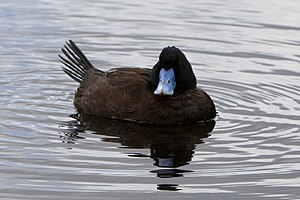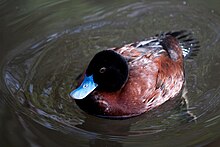Australian rowing duck
| Australian rowing duck | ||||||||||
|---|---|---|---|---|---|---|---|---|---|---|

Australian rowing duck ( Oxyura australis ) |
||||||||||
| Systematics | ||||||||||
|
||||||||||
| Scientific name | ||||||||||
| Oxyura australis | ||||||||||
| Gould , 1836 |
The Australian rowing duck ( Oxyura australis ) is a small species from the subfamily of rowing ducks . BirdLife International has this type in the Near Threatened early warning level . This means that if the population continues to decline, this species must be classified as threatened. The main threat to this species comes from draining wetlands. Other disadvantageous developments are the change in the biodiversity of these habitats due to introduced fish species , the grazing of cattle on the periphery of the marshland, their salinization and the lowering of the water table . The population is currently estimated at 12,000 sexually mature individuals.
description
The Australian rowing duck is a small rowing duck with an average body length of 40 centimeters. In the male, the head and neck are black and drowned out a little soot-brown. The body plumage is very dark red-brown. Like some other species of rowing duck, the male of the Australian rowing duck in its splendid plumage has a striking blue beak. In English usage, the duck is therefore also called blue-bill duck , in German blue-billed duck . A few males show their splendid dress all year round.
When resting, both males and females have a slate-gray beak. The plumage is then inconspicuously gray-brown. In the male, the head is just a little darker and the flanks are a little stronger brown.
When swimming, the Australian rowing duck lies very deep in the water. The tail usually lies flat on the surface of the water. If the birds are excited, it is spread stiffly upwards. These characteristics are also found in other rowing ducks.
Young birds that are not yet sexually mature are similar to females, but are generally a little lighter in color.
Typical behaviors
Outside of the breeding season, Australian rowers typically stay in large flocks on large, clear lakes. During the breeding season, on the other hand, they live in thickly overgrown swamps with a high water level. In the coastal regions these are mainly swamps that are densely overgrown with myrtle heather . The flight of the Australian rowing duck is very fast, and the instrumental sounds clearly make wing flapping noises. On the other hand, Australian rowing ducks do not call in flight. They rarely stay on land. However, they occasionally climb tree trunks that float in the water to groom themselves. However, they spend their rest phases swimming on the water. The individual dives last 10 to 30 seconds. A large part of the food intake takes place during the day.
Possible confusion
Australian bog duck , coot and coot are also found in the habitats used by the Australian rowing duck . These species are often associated with one another, especially outside the breeding season.
The coot is similar in size, but appears larger when swimming than the Australian rowing duck, as it swims higher in the water. The head is significantly smaller compared to the Australian rowing duck. Due to the bright and differently shaped beak and the white forehead shield of the coot, the two species should not be confused with each other when visibility is good. The movements differ significantly, so that the two species can be easily distinguished from one another, even from a greater distance. The coot initiates diving processes with a plunge, while the Australian rowing duck submerges with a flowing movement from its swimming position. Coots and Australian rowing ducks that fly up on the water require long approaches, but the approach of the coot is longer and the individual step movements are more noticeable. Both species are similar in their flight patterns, often fly in small groups and low above the water, so that the two species are difficult to distinguish in flight.
The Australian bog duck has a similar plumage color. The males have showy white eyes and a pale streak of beak. They are generally larger than the Australian rowing duck and have a longer and slimmer neck. Australian bog ducks swim relatively high in the water. Australian bog ducks also initiate their dives with a characteristic plunge, which is not the case with the Australian rowing duck.
With a body length of up to 66 centimeters for males and 55 centimeters for females, the rag duck is significantly larger than the Australian rowing duck. However, the plumage is similar to that of the Australian bog duck, and especially young birds of the rag-duck can be confused with the Australian rowing duck. However, the beak of the rag-duck is significantly stronger, and Australian rowing ducks have a concave head profile that the rag-ducks lack.
Distribution, habitat and way of life
The Australian rowing duck is an endemic species of the temperate climates of Australia . It is found in the south of Queensland through New South Wales and Victoria to Tasmania . The species is widespread in the southwest of Western Australia. They are very numerous along the Murray and Darling rivers . The extent to which the Australian rowing duck is a migratory bird is controversial. While some authors see a seasonal migratory movement, other ornithologists take the view that these are young birds that establish their breeding ground in the fringing area of the distribution area. Adult birds with an established breeding area, on the other hand, stay in their breeding area all year round.
The Australian rowing duck is very closely tied to water in its way of life. It can occasionally be seen on land. However, her gait appears awkward due to the legs set very far back on the body. Outside the breeding season, the Australian rowing ducks gather in flocks. Winter swarms of over 1000 individuals are known from New South Wales. However, during the breeding season they lead a very hidden existence and are very difficult to observe. When in danger, they usually do not fly up, but rather dive away.
Reproduction
The males' courtship ritual is long and complicated with very specific movement sequences. This includes rubbing the cheeks on the back feathers or dipping the head into the water while water is splashed up with the feet. After the courtship and a determined pursuit, copulation takes place in the water. The female is completely submerged. Australian rowers are polygamous. In captive Australian rowers, one dominant male was usually mated to three females. The dominant male defended these females against other males and prevented a courtship ritual by the other males also on the water.
The breeding habitat is found in regions with permanent water-bearing swamps and lush vegetation. The female chooses the nesting site and builds the nest. The male usually leaves the female at the time of oviposition. An average clutch contains around five to six eggs. The eggs are greenish-white in color. The brood, which usually begins when the last egg is laid, is 24 to 26 days. The young birds are independent of the female parent bird by four to five weeks at the latest. A second clutch often occurs very quickly afterwards.
Australian rowers reach sexual maturity at around one year.
food
The Australian rowing duck eats seeds, buds and fruits of aquatic and marsh plants as well as small organisms. A large part of the plant food comes from algae fern and milfoil . The animal content in the diet makes up around 43 percent. The food is taken while diving on the water floor. The Australian rowing duck can stay underwater for up to ten seconds.
Protective measures
Measures to drain and regulate low-lying waters are seen as the main cause of the decline in the Australian rowing duck population. The Australian Environment Agency has therefore taken several measures to protect the habitat of this rowing duck species. This includes the maintenance of a sustainable water flow in such regions, measures against progressive salinization and regulations for grazing such areas.
Individual references, literature and web links
literature
- T. Bartlett: Ducks And Geese - A Guide To Management. The Crowood Press, 2002, ISBN 1-85223-650-7
- PJ Higgins (Ed.): Handbook of Australian, New Zealand & Antarctic Birds , Volume 1, Ratites to Ducks, Oxford University Press, Oxford 1990, ISBN 0195530683
- Hartmut Kolbe: The world's ducks. Ulmer Verlag 1999, ISBN 3-8001-7442-1
Individual evidence
- ↑ BirdLife Species Factsheet , accessed April 23, 2011
- ↑ a b c Frith, HJ, 1977, Waterfowl in Australia, Angus and Robertson, Sydney.
- ^ A b Marchant S. and Higgins PJ (eds) 1990, Handbook of Australian, New Zealand and Antarctic Birds Volume 1: Ratites to Ducks, Oxford University Press, Melbourne.
- ↑ a b Kolbe, p. 85
- ^ Higgins, p. 1142
- ^ Higgins, p. 1142
- ^ Higgins, p. 1145
- ^ Higgins, p. 1145
- ^ Kolbe, p. 86
Web links
- Oxyura australis inthe IUCN 2013 Red List of Threatened Species . Listed by: BirdLife International, 2012. Retrieved February 6, 2014.



